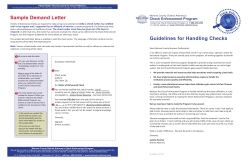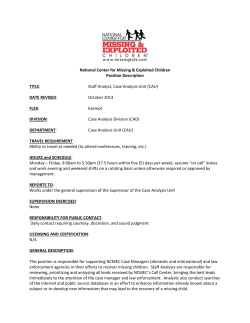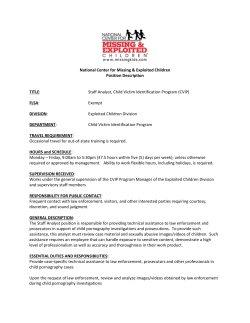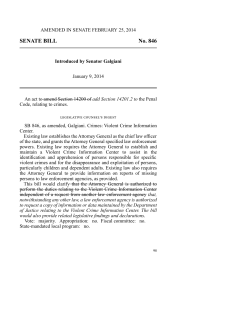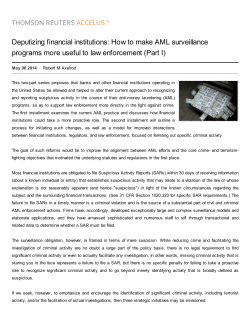
Payor-Provider Contract Management: How to Avoid
Payor-Provider Contract Management: How to Avoid Becoming a Horror Story 39 Offices in 19 Countries September 23, 2013 The Princeton Club New York City Speakers • John M. Kirsner, Columbus john.kirsner@squiresanders.com, +1 614.365.2722 • John Kirsner acts as both counsel and advocate for large and small hospitals, physician group practices, other healthcare providers, and imaging and lithotripsy development companies. His work involves the creation of foundation model arrangements, physician-hospital alignment, joint venture transactions, clinical integration, accountable care, contract analysis, group practice merger and formation, network formation and operation, managed care contracting, regulatory review, compliance issues, and recruitment and physician employment. • John is listed in The Best Lawyers in America for healthcare law and insurance law. He has been named an Ohio Super Lawyer each year since 2006. 2 Speakers Paul Gallese, Chicago pgallese@alvarezandmarsal.com, +1 312.601.9071 Paul Gallese is a Director with Alvarez & Marsal Healthcare Industry Group, LLC in Chicago. Mr. Gallese specializes in the development, operation, design, and restructuring of health care delivery systems, academic medical centers, risk bearing provider organizations and health insurers.. Prior to joining A&M, Mr. Gallese had extensive experience in the operations and finance of insurers, provider organizations, and integrated delivery systems. He has conducted and concluded complex negotiations for physician hospital joint ventures, physician compensation plans, and managed care capitation contracts on behalf of physicians, hospitals, and ancillary providers nationally. His clients included The University of Colorado School of Medicine, The University of Mississippi Medical Center, Florida Atlantic University, The University of Miami Miller School of Medicine, Children's Memorial Hospital in Chicago, Clark County Medical Center in Las Vegas Nevada, and The Children's Hospital, Denver In addition to his advisory and policy experience, Mr. Gallese has served in senior leadership and interim executive roles for health plans, hospitals, and medical groups. His senior leadership roles include the Lewin Group; The Albert Einstein Practice Plans (Philadelphia); Cleveland Clinic Florida, Mt, Sinai Medical Center (Cleveland, Ohio), and Salick Cancer Centers (Los Angeles). He served as a member of the commissioning team and Associate Administrator of USC University Hospital in Los Angeles. Currently, Mr. Gallese is engaged in a number of projects including restructuring and re-purposing of a safetynet hospitals and development of sustainable ambulatory care models. He has also served as the CEO of Community Health Plan of Washington, an $800 Million earned premium, 240,000 member Medicaid and Medicare Advantage Health Plan based in Seattle, Washington.. Mr. Gallese earned a bachelor's degree in physical therapy, with focus on neuroanatomy and pathokinesiology, from Marquette University. Mr. Gallese’s professional practice focused on Pathokinesiology and Sports Medicine. He has practiced in California, Nevada, New Mexico and Arizona. He earned a master's degree in business administration, with concentrations in strategy and finance, from Pepperdine University in Malibu, California. 3 Agenda • Healthcare Industry: Increasingly Complex & Changing Rapidly • Complexity and Change Æ Heightened Need for Compliance and Spur to Integration • Fundamental Observations • Managing the Unknown • Complexity and Change Æ Enforcement Risk • Horror Stories • Basic Best Practices • How to Avoid Becoming a Horror Story 4 Healthcare Industry: Increasingly Complex & Changing Rapidly ¾ Uncertainty: Current regulatory environment driving unprecedented unrest – New regulations and payment systems – New penalties – Focus on “value” and “quality” ¾ New push for integration, ACOs and the like – Range of vertical integration strategies, hospitals acquiring and developing other businesses – Creates new ongoing Stark/Anti-Kickback/CMP/Antitrust issues that increase legal risk – ACO waivers – Proper contracting model and compliance strategies extremely important ¾ Insurance Exchanges (developments) – Narrow networks – Leverage pendulum shifting towards payers rather than providers – New reporting and compliance requirements ¾ Changing Payment Structures – Moving away from fee for service models toward quality and outcome-based models » Shared savings » Bundling/Global Payments ¾ Projected Increased Spending – Funding the added coverage 5 Hospital Finances: In a Shrinking Bubble Medicare value purchasing Ostensible decrease in the number of uninsured Statutory DSH Reductions Hospital finances Increased Medicaid coverage & mobility Reduced Medicare Payments Lower Medicaid DSH 6 Hospital IP Æ OP Shift Hospital Outpatient Visits and Inpatient Bed days per 1,000 population 1990 to 2010 2500 2000 1500 1000 500 Outpatient 2010 2009 2008 2007 2006 2005 2004 2003 2002 2001 2000 1999 1998 1997 1996 1995 1994 1993 1992 1991 1990 0 Inpatient Source: AHA Trendwatch Data 7 Hospital IP National Admission Trends Millions Source: AHRQ HCUPNet 8 Evolution of Payment Models: Public Funding Fee for service Per diem Inpatient DRG Episode of care Multi-provider episode of care payment Diagnosis or condition specific capitation (health system at-risk) Full capitation (health system at-risk) Source: HD Miller. Creating Payment Systems to Accelerate Value Driven Health Care. Issues and Options for Policy Reform. Commonwealth Fund, Sept 2007 Growing “Creativity” in Public Payment Models…not our first journey through this healthcare business cycle • Medicaid redesign models: New York State • Single Payer redesign: Maryland • Novel Medicaid Expansions: RI, OK, AR Providers face increasing complexity, increasing regulatory challenges and a range of resulting financial challenges. Government payers are increasingly utilizing downstream risk vehicles that appear to be commercial contracts. The reality is: providers are increasingly reimbursed by public funds and are, therefore subject to public payer rules, regulations, audits and scrutiny 9 Complexity and Change Æ Heightened Need for Compliance and Spur to Integration • Implement and carry out compliance plans ¾ Need to live up to perceptions of consumers and regulators ¾ Need to oust bad behavior • Providers live in an increasingly challenging space that demands, by virtue of market forces, a radical change in business and operational mindset ¾ Consolidation ¾ Merger Integration ¾ Market Rationalization ¾ Business Scale ¾ Vertical Integration Strategies • New push for integration, ACOs and the like ¾ Range of vertical integration strategies, hospitals acquiring and developing other businesses ¾ Creates new ongoing Stark/Anti-Kickback/CMP/Anti-trust issues that increase legal risk ¾ ACO waivers ¾ Proper contracting model extremely important 10 Hospital “Deal Flow”: Pace of Consolidation Increasing All Hospitals 111 $14.0 $12.0 $8.0 $12.3 90 $10.0 60 $9.2 76 60 120 $9.9 80 52 $7.9 60 50 $6.0 $4.0 100 40 $4.3 $3.8 $2.5 $2.0 20 $0.0 0 2007 2008 2009 2010 2011 2012 2013YTD Number of Transactions Announced Dollar Value of Transactions ($ in Billions) 11 Government Sources “Own” Healthcare • In 2010, total public spending for healthcare services exceeded 50% of total national health expenditures NHE, billions NHE per capita 2009 2010 2011 $2,495.80 $2,593.60 $2,695.00 $8,148.60 $8,402.30 $8,660.50 GDP, billions of dollars $13,939.00 $14,526.50 $15,093.00 $15,696.80 $16,387.40 $17,223.20 $24,395.30 NHE as percent of GDP 17.91% 17.85% 17.86% 2012 $2,809.00 $8,952.80 17.90% 2013 $2,915.50 $9,214.20 17.79% 2014 $3,130.20 $9,807.50 18.17% 2021 $4,781.00 $14,102.60 19.60% Wall Street Journal 4 February 2010 Keehan S P et al. Health Aff doi:10.1377/hlthaff.2012.0404 12 Hospitals “Sell” Reputation First: What is “Value”? 1. Lieberman, Trudy. "Do Hospital Ratings Matter?" Centers for Advancing Health. June 2012. 2. Abraham, Jean, et al. "Selecting a provider: what factors influence patients' decision making?." Journal of healthcare management/American College of Healthcare Executives 56.2 (2011): 99. 13 Fundamental Observations 1. The US healthcare system is commanding increasing amount of funding from all sources, primarily government sources. Public payer sources will increase as a percentage of total for most providers. 2. Hospitals are reacting to changes in healthcare finance by deploying vertical integration strategies. So called “headwaters” strategies (get closer to the payer source) have driven hospitals to become insurers, home health providers, physician groups, etc. 3. Providers are consolidating to create business scale and more survivable financial models. Provider consolidation is rampant and will likely continue for the foreseeable future. 4. Increased market footprint combined with increasing public funding makes providers more likely regulatory targets. Providers are increasingly challenged to create and maintain complex and thorough compliance functions designed to withstand regulatory scrutiny. 14 Managing the Unknown 15 Complexity and Change Æ Enforcement Risk • Why the enormous focus on reducing healthcare fraud? ¾ PRACTICAL: government views this money as stolen or wasted ¾ The Government’s return-on-investment for healthcare investigations is over $7.90 per every $1.00 expended ¾ In 2012, Government collected $4.2 billion for healthcare fraud ¾ States are joining in this effort with respect to Medicaid Fraud and increased enforcement of State anti-trust and anti-kickback laws Fiscal Year Total $ Recovered Return-on-Investment FY 2012 $4.2 Billion 2010-2012 = $7.90 FY 2011 ≈ $4.1 Billion 2009-2011 = $7.00 FY 2010 ≈ $4.02 Billion 2008-2010 = $6.80 FY 2009 ≈ $2.58 Billion Since 1996 = $4.00 FY 2008 ≈ $2.14 Billion NA FY 2007 ≈ $1.07 Billion NA 16 Complexity and Change Æ Enforcement Risk Meet your Regulators: • Usually work together but are not required to • States cooperate with federal agencies as well 17 Complexity and Change Æ Enforcement Risk Increased Enforcement of the following laws: • Stark Law (42 U.S.C. § 1395nn) ¾ Prohibits physicians from making referrals for certain designated health services payable by Federal Health Care Programs to an entity with which physician or immediate family member has financial relationship ¾ Penalties include denial of payment, refund of overpayments, exclusion, civil penalties ranging from $15,000 per each service to $100,000 per each circumvention scheme, failure to report civil monetary penalties ¾ Enforcement authority in CMS and OIG (HHS) • Anti-Kickback Statute (42 U.S.C. § 1320a-7b) ¾ Prohibits remuneration paid purposefully to induce or reward referrals of items or services payable by Federal Health Care Programs ¾ Criminal penalties of maximum fine of $25,000, imprisonment up to 5 years, or both, and automatic exclusion and civil monetary penalties ¾ Enforcement authority in OIG (HHS) 18 Complexity and Change Æ Enforcement Risk Increased Enforcement of the following laws: • Civil Monetary Penalties (“CMP”) Law (42 U.S.C. § 1320a-7a) ¾ OIG may seek CMPs for a variety of conduct including False Claims, violation of the Anti-Kickback Statute, the Stark Law, and hospital’s violation of EMTALA. ¾ Penalties include treble damages of amount improperly claimed and varying penalty amounts per violation (form $10,000 to $50,000) ¾ Enforcement authority in OIG • False Claims Act (“FCA”) (31 U.S.C. §§ 3729–3733) ¾ Prohibits persons and companies from defrauding federal programs by ¾ ¾ ¾ ¾ ¾ improperly receiving payments from or avoiding payment to the federal government Qui Tam provision that allows civilians to bring claims on behalf of the government (known as “whistleblowing”) Incentive = Relator receives between 15-25% of the recovery Can recover treble damages and attorney’s fees Complaint must be filed under seal Enforcement authority in DOJ 19 Complexity and Change Æ Enforcement Risk Increased Enforcement of the following laws: • Antitrust Laws ¾ Sherman Act: outlaws "every contract, combination, or conspiracy in restraint of trade," and any "monopolization, attempted monopolization, or conspiracy or combination to monopolize.“ – criminal penalties of up to $100 million for a corporation and $1 million for an individual, along with up to 10 years in prison – the maximum fine may be increased to twice the amount the conspirators gained from the illegal acts or twice the money lost by the victims of the crime, if either of those amounts is over $100 million ¾ Clayton Act: prohibits mergers and acquisitions where the effect "may be substantially to lessen competition, or to tend to create a monopoly.“ – authorizes private parties to sue for triple damages when they have been harmed by conduct that violates either the Sherman or Clayton Act and to obtain a court order prohibiting the anticompetitive practice in the future ¾ FTC Act: prohibits "unfair methods of competition" and "unfair or deceptive acts or practices" – all violations of the Sherman Act also violate the FTC act ¾ Enforcement authority in DOJ, FTC, State AGs, and private citizens ¾ FTC specifically addresses antitrust enforcement policy in health care 20 Complexity and Change Æ Enforcement Risk Increased Enforcement of the following laws: • Tax Issues • 501(c)(3) issues: ¾ Maintaining tax exempt status in era of consolidation and ventures with for- profit corporations ¾ ACA’s new 990 and Schedule H requirements for charitable 501(c)(3) hospitals • Penalties for ACA individual mandate non-compliance starting 1/1/14: ¾ 2014 = the greater of $95 per person or 1% of taxable income ¾ 2015 = the greater of $325 per person or 2% of taxable income ¾ 2016 = the greater of $695 per person or 2.5% of taxable income ¾ Enforcement Authority in IRS • State Versions of the Above Laws enforced by the States ¾ Not precluded from pursuing separate state action for violation of state laws ¾ States cooperate with Federal Government for recovery of Medicaid money 21 Complexity and Change Æ Enforcement Risk Creation of various federal entities targeting healthcare fraud: • Health Care Fraud and Abuse Control Program (HCFAC) ¾ based on cooperation of AG and HHS • Health Care Fraud Prevention and Enforcement Action Team (HEAT) ¾ based on cooperation of AG and HHS • Recovery Audit Contractors (RAC) through CMS • Medicaid Fraud Control Units • Medicare Fraud Strike Force Teams (currently nine of them) • National Fraud Prevention Partnership ¾ Private insurers and federal government share claims data 22 Complexity and Change Æ Enforcement Risk Primary avenues for enforcement: • Government Encourages FCA lawsuits filed by whistleblowers ¾ Relator files suit under seal; DOJ gets notification, does preliminary investigation, involves other agencies as necessary, and decides whether to intervene or not ¾ If decision not to intervene, DOJ kicks back to agency for enforcement ¾ Company doesn’t know what is happening or who relator is because suit is under seal – 647 qui tam actions filed in 2012 – $439 million to whistleblowers in 2012 • Data mining through agencies ¾ Agencies use powerful computers to crunch large amounts of data to locate “outliers” who treat patients differently than his/her peers ¾ Interested in those who bill for expensive services or bill more frequently than the norm • Self-Disclosure through Anti-Kickback Statute and Stark Law ¾ Parties disclose their own actions they believe violate the law in hopes of reaching a favorable settlement 23 Complexity and Change Æ Enforcement Risk Life Cycle of an Investigation: 1. Government gathers information; could be in form of: ¾ attestation statements prior to an audit ¾ basic telephone call for voluntary production of documents ¾ civil investigative demand ¾ grand jury subpoena ¾ administrative healthcare subpoena ¾ search warrant 2. Conducts investigation ¾ usually lengthy; evaluates documents, conducts interviews ¾ government can disappear for 6 months at a time but likely still investigating ¾ government has long statute of limitations and tends to use it 3. Work toward a settlement or go to trial on FCA • Typical investigation/case lasts 2-4 years 24 Horror Stories • – consultant was relator in Qui Tam action ¾ no compliance plan or enforcement ¾ Settlement Amount: $26 million in 2013 • – Whistleblower FCA suit ¾ fair market value issues ¾ Settlement Amount: $11.5 million to US, $2.6 million to State of California, $2.8 million to whistleblowers and 5 year CIA in 2013 • - 1st issue: CMS Investigation; threat of loss of Medicare serious threat to patients; Corrective Action Plan - 2nd issue: Whistleblower FCA suit but fully cooperated ¾ up-coded charges and medically unnecessary procedures ¾ Settlement Amount: $1.4 million and 5-year CIA in 2013 25 Horror Stories • – Sacred Heart Hospital of Chicago CLOSED due to fraud investigation ¾ FBI raided hospital and CEO, CFO, and four physician arrested for kickback scheme in which doctors were bribed to admit Medicare patients to hospital ¾ Closed after Medicare decided to suspend payment for 180 days 26 Horror Stories • - Former employee whistleblower FCA suit - Paying doctors in exchange for referring cardiac patients to hospital ¾ Settlement Amount: $108 million to US with $23.5 million to relator and 5-year CIA in 2010 • - FCA suit appealed to the 4th Circuit - Fair market value and commercially reasonable compensation issues ¾ Circuit court vacated district court’s verdict on procedural grounds and remanded for retrial ¾ The new jury found violations of the Stark Law and FCA with 21,730 false claims valued at $39,313,065 before adding treble damages, which could exceed $200 million ¾ Final judgment still being negotiated with government 27 Horror Stories • - Medicare Advantage Whistleblower FCA suit - Health Plan Medicare/Medicaid Overpayments ¾ Settlement Amount: $129.4 million to the US, $190.5 million to California, $3.8 million to US to settle whistleblower suit in 2012 • - 1st offense: Criminal Medicaid investigation - Result: Entered into a DPA for $40 million in restitution and forfeiture of an additional $40 million in 2009 - 2nd offense: Four separate FCA suits in 2012 ¾ False inflation of amounts spent, knowingly retained overpayments, cherry- picking, misrepresentation of patient medical conditions, etc. ¾ Settlement Amount: $137.5 million with interest in fixed payments over three years to US and nine states; $35 million contingent payment for sale of company or change in control within three years of agreement; $20.75 million to one relator and the others share $4.66 million 28 Horror Stories • – FTC case that went to Supreme Court ¾ Phoebe attempted to acquire Palmyra, the only other competing hospital in the Albany, Georgia area, resulting in a merger to monopoly ¾ In 2013, Supreme Court ruled in favor of the FTC holding that the State of Georgia has not clearly articulated a policy that allows hospital authorities to make acquisitions that substantially lesson competition, therefore state action immunity doctrine does not apply ¾ Settlement: – Does not require Phoebe Putney to divest the hospital – Does not impose price caps or information firewalls to allow for separate, confidential negotiations between each hospital and managed care plans – Requires Phoebe Putney to give the FTC 30 days prior notice of certain future acquisitions in the six-county area surrounding Albany, Georgia, for the next 10 years – Prohibits Phoebe Putney “from raising any objections to or providing negative comments about [state certificate of need (CON)] applications for general acute-care hospitals in the six-county area surrounding Albany, Georgia” 29 Horror Stories • - FTC case decided in 2012 ¾ Acquisition of hospital in Lucas County, Ohio would harm competition and allow ProMedica to raise prices of general acute care inpatient hospital services and obstetrical services ¾ Required to divest St. Luke’s Hospital to approved buyer within 180 days of date that the order become final and effective ¾ Appealed to the Sixth Circuit • vs. - Pending private payer suit for insurance fraud and common law fraud filed in 2013 ¾ Alleges Alere/Avee “distributed unlawful marketing materials which were intended to mislead and in fact, misled health care providers into performing unnecessary POCT and ordering unnecessary confirmatory tests from Avee” ¾ Horizon is seeking $36 million in actual damages plus treble damages 30 Basic Best Practices • Realize that whistleblowers are often driven by hurt feelings/being dismissed; believe they have a higher calling ¾ if you encourage/acknowledge them and fix the problems, then might not turn into FCA lawsuit • Don’t ignore importance of government requests; no matter how trivial, attend to the matter ¾ hire a lawyer for guidance and for benefit of privilege ¾ turn over data in context ¾ engage early and cooperate fully • Have alerts in system about government requests; have a system to address government requests • Run your own data mining to see where you may look abnormal and have an explanation for that; make sure within national trends and if not document why not • NEVER destroy evidence • Be careful what you say and where you say it (emails, texts, and social media can and will be used against you) 31 How to Avoid Becoming a Horror Story Contract Drafting • Can’t be a mechanical response; the relationships between the parties are as important as the words in the contract ¾ Codify the relationship in the contract • Perform adequate due diligence ¾ Illuminates the current state of the parties ¾ Allows parties to take into account the current state and special circumstances • Drafting and organization ¾ Create/negotiate innovative deal terms and maintain all draft iterations ¾ Basic honesty and common sense ¾ Understand concepts of Fair Market Value and Commercial Reasonableness and utilize independent third party valuations • Use ACO waivers very carefully ¾ Know existing Stark/FTC analysis and State Law ¾ Understand that waivers only apply to ACO patients • Plan ahead so deadlines for ACA mandates are met; bundling; valuebased purchasing and re-admission rates 32 How to Avoid Becoming a Horror Story Operationalize the Contract • Get operational and finance staff on board/more involved to help with compliance issues • Successful compliance requires putting yourself in a defensible position if an investigation occurs ¾ IT systems providing real time info ¾ Proper monitoring and reporting; as talked about in basic best practices ¾ QI and UM • Create execution plan and do it to a tee; more forgiving later if genuine attempt is clearly evident ¾ Lack of enforcement of the institution’s own rules is a very common indicator of business failure 33 Conclusion - A New Reality • Providers are bearing more risk and the burdens of compliance and performance • Providers must understand this and adapt to this new responsibility • Operate as responsible stewards of public funds • Develop and maintain an operating “culture of compliance” ¾ Imbed compliance into the organization’s culture ¾ Engage in informed rule-making – no room for speculation or un-informed interpretation of complex rules ¾ Operate from a “glass house” platform – Assume added scrutiny and the need for complete transparency ¾ Develop, make, and enforce rules without exception – No “side deals” or “special cases” – The exceptions to the rules are generally of greatest interest to the regulators – In the long run: if it does not feel right it probably is not right so...don’t do it 34 Questions? 35 Payor-Provider Contract Management: How to Avoid Becoming a Horror Story 39 Offices in 19 Countries September 23, 2013 The Princeton Club New York City
© Copyright 2025

